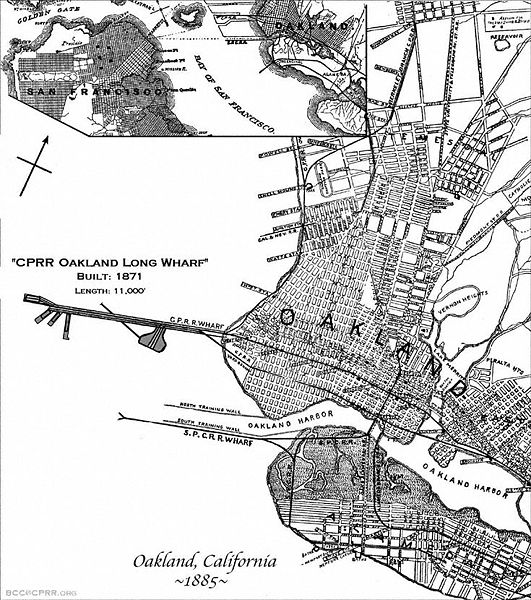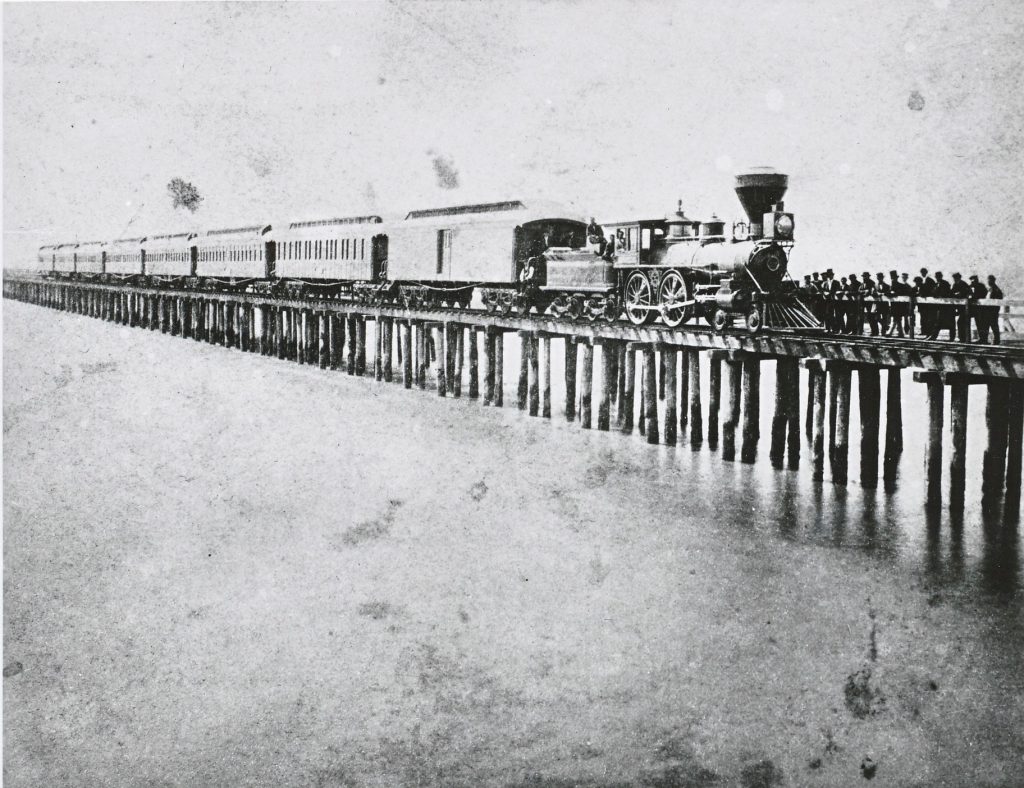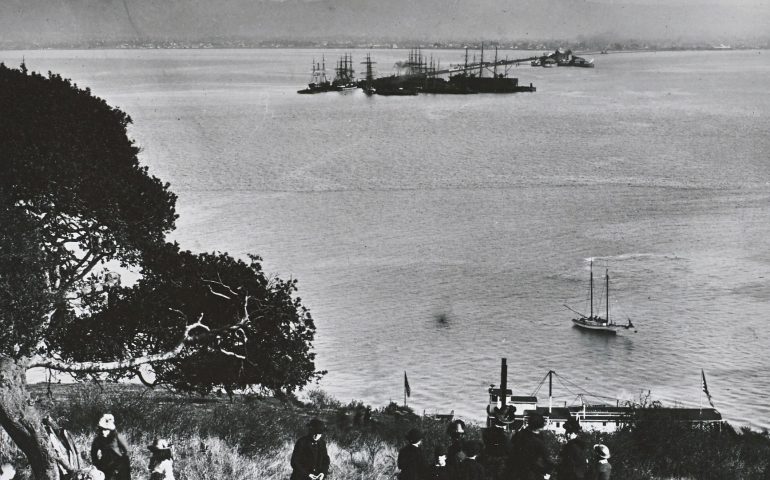The Long Wharf as seen from Goat Island, now called Yerba Buena Island
The Oakland Long Wharf also later known as the Oakland Pier and South Pacific (SP) Mole was an 11,000-foot long railroad wharf and ferry pier in Oakland, one of the most important wharves in San Francisco Bay and California
Like most of early wharves it was built for commercial purposes. Like most of the early wharves it would be adopted as a place to fish whenever allowed as demonstrated below.
West Oakland The murky mornings of the past few days, while disagreeable to humanity in general, have been hailed with delight by the anglers on the Long Wharf, and big catches of fish, such as smelt, rock-cod, tom-cod, etc., are reported by local fishermen. The waters about the bay in the neighborhood of the Wharf and Mole still swarm with small sharks, and to a great extent interfere with anglers. These young monsters of the deep bite at anything from a carpet tack to a railroad spike, and the fishermen’s angle and grub worm bait have no chance whatever. The young sharks, in several instances, are reported to have swallowed the hooks and then bit the line in two. —Oakland Evening Tribune, August 12, 1885
At the railroad wharf, at Oakland, smelt fishing has been quite good, and what is quite unusual, a number of young salmon trout, weighing from one to two pounds each, have been taken. —San Francisco Chronicle, September 14, 1886
Giant Fish Is Hooked In Bay — Steelhead Salmon Caught Off Long Wharf
“Porky” Thomas, a local longshoreman has gained renown along the front as a fisherman. Yesterday afternoon while fishing off Long Wharf “Porky” hooked a giant steelhead salmon, which required two men to haul in. The salmon when put on scales weighed thirty-five pounds. For a time it was suggested by some of the lucky fishermen’s friends, that he put the fish on exhibition at the local museum. This “Porky,” however, refused to do, and gathering up the remainder of his catch which amounted to more than 100 pounds, sold it to a local Chinaman. —Oakland Tribune, December 30, 1911

“During the (eighteen) sixties, seventies, and eighties, thousands of so-called ‘grilse’ or ‘salmon trout’ were caught by hook and line by fishermen fishing off ‘Meiggs Wharf,’ from the wharfs all along the San Francisco waterfront, and off the Oakland Mole. On any Sunday during the fall months of these years hundreds of fishermen could be seen all along the wharfs of San Francisco Bay and the Oakland Mole fishing for steelhead trout. The rig used by these fishermen was similar to that used by smelt fishermen, being a bamboo cane pole, cork float, and hooks baited with mussel, pile or angle worms, and fresh shrimps.” —Walter R. Welch, Trout Fishing in California Today And Fifty Years Ago,California Fish and Game Magazine, January, 1929
The Old Long Wharf
The Oakland Long Wharf as it was called, was an early institution on the western waterfront. It started from about where the Albers dock is now located at the foot of Seventh Street and ran out into the Bay until deep water was reached on a line with the present Key Route slips. To the old Long Wharf came all kinds of ships, but mainly sail driven craft. The wharf was a shipping point for sugar as well as other types of general cargo. The tall-masted ships, in or outbound to the ports of the South Seas would line in alongside the bulkheads and with whips rigged to their yardarms would sling the various shipments aboard or onto the dock.
The wharf was supposed to be forbidden territory to small boys and fishermen but many were the times when the youth of Oakland sneaked out there and dropped their lines overboard. The watchmen were tolerant as long as the fishermen did not get in the way of the dockworkers.
In those days sturgeon were plentiful in the Bay but they were hard for the average youngster to catch or land. Then one bright genius conceived the idea of attaching a stout cord, with hooks and bait, to a Standard Oil coal oil can. With this as a float the largest sturgeon found it impossible to sound and break the tackle after being hooked.
But amusing experiences sometimes took place when one of the big fish became so hooked. The Dogwatch remembers once how he and a couple of friends had gone after sturgeons and managed to hook a big one. This fish was a fighter and instead of being in after tiring itself out by battling the oil can, it seemed to grow stronger. Then it took off down the face of the wharf towing the buoy with it. At the time the wharf was lined with a large number of grownup fishermen not at all interested in sturgeon. As the big fish and its can came tearing along there was a general tangling of lines many of which were whipped into the Bay and lost. During the ensuing snarl-up the Dogwatch and his companions laid down their lines and made a fast sneak away from the Long Wharf. If they hadn’t they would have been tossed into the Bay with their sturgeon by the irate fishermen on the dock. —Frank Kester, Oakland Tribune, March 17, 1940
History
The Long Wharf started as a short wharf called Gibbon’s Wharf that extended from Gibbons Point (later Oakland Point) into the bay. In 1868, the wharf was acquired by the Central Pacific Railroad, which soon began improvements, including lengthening it while renaming it the Oakland Long Wharf.
On November 8, 1869, the Long Wharf became California’s principal rail terminus — the western end of the first transcontinental railroad. Ferries soon carried both commuters and the transcontinental travelers who had arrived west from throughout the United States; they rode the railroad to Oakland and the ferry to San Francisco.
The first Oakland Pier (a trestle pier), built around 1863, also originating on the point, was extended out 6,900 feet by the Central Pacific in 1869. By 1871, the Long Wharf was parallel to the Pier.

Then, between 1879 and 1882 part of the Pier was filled in as an earth embankment and extended creating a mole that opened as the Oakland Mole in 1882. The 1880s also saw the Central Pacific’s operations consolidated under the Southern Pacific with improvements made to the Long Wharf including a terminal building out at the end.
Like most wharves, the Long Wharf would see occasional change including welcoming the electric commuter trains when they began to run throughout Oakland.
But, the building of the Bay Bridge signaled the beginning of an end to the Long Wharf (although it would still last for a period of time). On January 15, 1939, the electric commuter trains ceased their operations on the wharf, which by then was officially called the Oakland Pier by Southern Pacific and the SP Mole by many. The electric trains would carry their passengers over the Bay Bridge to the Transbay Terminal in San Francisco.
Regular passenger trains did continue to run to the pier until 1958 when the last Southern Pacific ferryboat from Oakland to the Ferry Building in San Francisco ended. The Oakland Long Wharf, Oakland Pier, and SP Mole would simply remain as memories when the wharf/pier was demolished in the 1960s.
